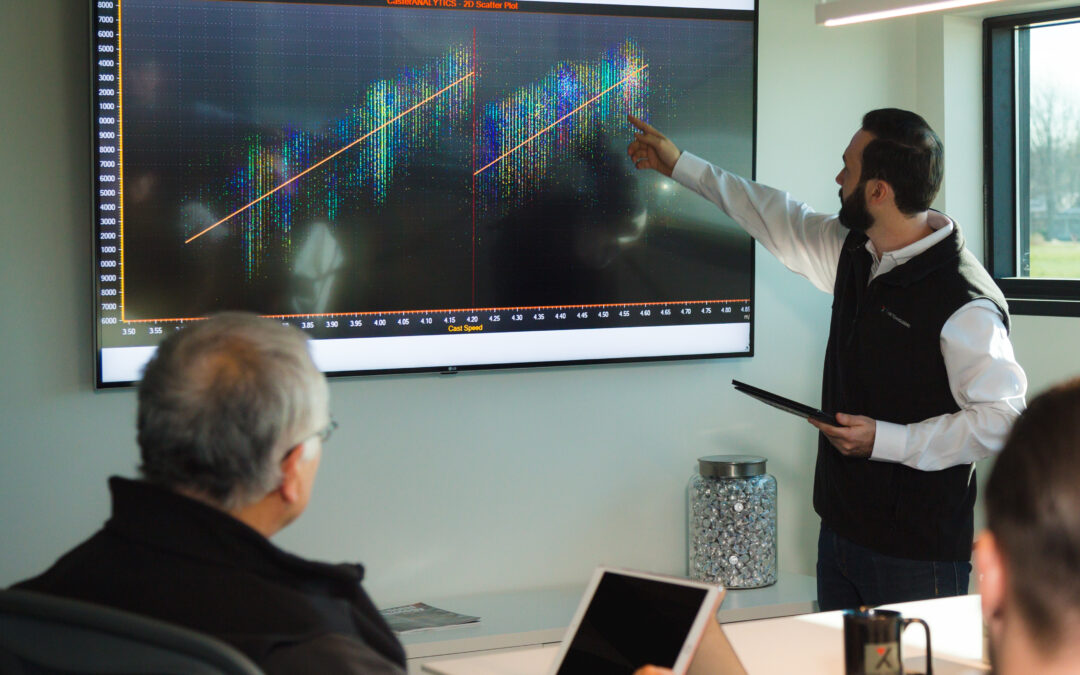This blog post covers historical data analysis, real-time monitoring, predictive analytics, machine learning, and data visualization techniques that steelmakers can use to optimize their continuous casting process and stay competitive in the global market.
In our previous blog post, we discussed the various types of data a steelmaker should be using for a modern data-driven continuous casting machine. In this follow-up post, we will explore how a steelmaker should look at this data to improve their continuous casting process. Broadly, the process looks like this:
- Analyze Historical Data
- Implement Real-Time Monitoring
- Use Predictive Analytics
- Implement Machine Learning
- Use Data Visualization
Analyze Historical Data
The first step a steelmaker should take is to analyze historical data to identify trends and patterns in the casting process. By analyzing data on process parameters, material properties, environmental data, equipment data, and production data, steelmakers can identify areas for improvement and develop strategies to optimize the casting process.
To effectively analyze historical data, steelmakers should use data visualization tools to help them understand and interpret the data. These tools can help identify trends, patterns, and correlations that may not be apparent from raw data alone.
By visualizing the data, steelmakers can quickly spot issues and opportunities for improvement and make informed decisions to optimize the casting process. Additionally, they can use machine learning algorithms to further analyze the data and identify hidden patterns that may not be apparent from initial analysis.
Implement Real-Time Monitoring
Real-time monitoring of the casting process is crucial for identifying and addressing issues as they occur. By installing sensors and collecting data on process parameters, material properties, environmental data, and equipment data in real time, steelmakers can quickly detect anomalies and make adjustments to the casting process. This can help prevent defects in the final product and ensure that production targets are met.
To make the most of real-time monitoring, it is important for steelmakers to establish clear and specific performance metrics that can be tracked in real-time. This allows operators to easily identify deviations from normal operating conditions and quickly take corrective action.
Additionally, the use of automated alerts and notifications can help ensure that issues are addressed promptly, even if they occur outside of regular working hours. Overall, real-time monitoring is a critical tool for ensuring that the casting process runs smoothly and that issues are identified and addressed as soon as possible.
Use Predictive Analytics
Predictive analytics can help steelmakers anticipate issues before they occur. By using historical data and real-time monitoring, predictive analytics can identify patterns and predict future outcomes. For example, predictive analytics can help identify when equipment is likely to fail, allowing steelmakers to perform maintenance before a failure occurs.
Additionally, predictive analytics can also help steelmakers optimize the casting process by predicting the best process parameters for a given set of material properties and environmental conditions. This can help steelmakers improve product quality, reduce production costs, and increase efficiency by minimizing the amount of trial and error required to determine optimal process parameters.
Implement Machine Learning
Machine learning algorithms can help steelmakers optimize the casting process by continuously analyzing data and identifying patterns that may not be apparent to humans. By using machine learning, steelmakers can develop models that predict the best process parameters for a given set of material properties and environmental conditions.
Furthermore, machine learning algorithms can be used to optimize the casting process by identifying correlations and patterns in large datasets that are difficult or impossible for humans to spot. This can help steelmakers identify new opportunities for improving the process, such as optimizing the use of resources or reducing waste. Machine learning can also help steelmakers identify the root causes of problems and develop more effective solutions to them.
By continuously analyzing data and using machine learning algorithms, steelmakers can stay ahead of the competition and continue to improve the performance and efficiency of their continuous casting process.
Use Data Visualization
The visualization of the data and analysis is critical to realizing the benefits of the technology. Operators can interface with dashboards for real-time monitoring of process data and analytical calculations giving them the information they need for operational decision making. Standard reporting is useful for tracking performance towards goals and specific KPIs.
In addition, visualization of the data can help steelmakers gain a better understanding of the trends and patterns in their data. Data visualization tools can help steelmakers identify correlations and outliers in their data, and provide insights that can lead to process improvements. Visualization can also help operators make decisions in real-time by presenting data in an intuitive and easy-to-understand format. Steelmakers can leverage various data visualization techniques such as graphs, charts, and heat maps to better understand their data and make informed decisions.
Kiss Technologies Can Help Steelmakers Gather Data
Steelmakers can use data-driven technologies to optimize their continuous casting process — and we can help with that here at Kiss Technologies.
By analyzing historical data, implementing real-time monitoring, using predictive analytics, and implementing machine learning, steelmakers can identify areas for improvement, prevent defects, and increase productivity. By leveraging the power of data analytics, steelmakers can stay competitive in the global market and continue to produce high-quality steel products.
Bring real-time visibility to the casting process with Kiss Technologies’ CasterANALYTICS platform. Our team of steelmaking experts will help you store, manage, analyze, and make sense of your data. You’ll get scientific insight into your continuous casting process, arming you with the information you need to make data-based decisions.
If you’re ready to put data to work for you, Kiss Technologies has the data solutions you’re looking for. Get in touch with our team for more information.
5 Ways to Improve Quality and Production
Learn how to identify patterns, predict quality defects, optimize productivity and make informed decisions with data analytics to enhance your continuous casting process.

